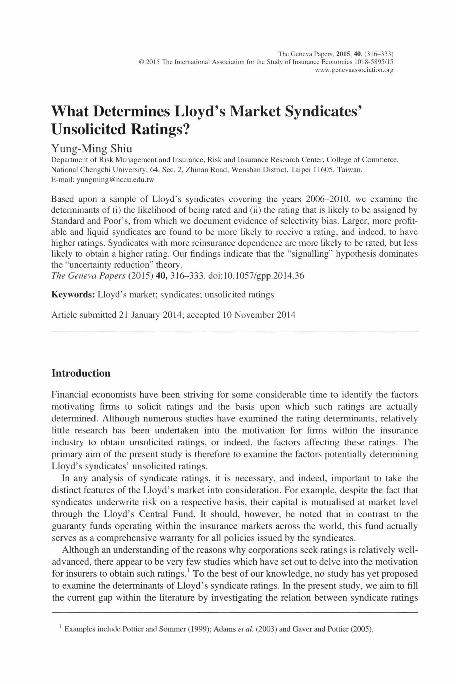What determines Lloyd's market syndicates' unsolicited ratings?

Contenido multimedia no disponible por derechos de autor o por acceso restringido. Contacte con la institución para más información.
| Tag | 1 | 2 | Value |
|---|---|---|---|
| LDR | 00000cab a2200000 4500 | ||
| 001 | MAP20150019202 | ||
| 003 | MAP | ||
| 005 | 20150528125405.0 | ||
| 008 | 150521e20150406esp|||p |0|||b|spa d | ||
| 040 | $aMAP$bspa$dMAP | ||
| 084 | $a2 | ||
| 100 | $0MAPA20110019587$aShiu, Yun-Ming | ||
| 245 | 1 | 0 | $aWhat determines Lloyd's market syndicates' unsolicited ratings?$cYung-Ming Shiu |
| 520 | $aBased upon a sample of Lloyd's syndicates covering the years 20062010, we examine the determinants of (i) the likelihood of being rated and (ii) the rating that is likely to be assigned by Standard and Poor's, from which we document evidence of selectivity bias. Larger, more profitable and liquid syndicates are found to be more likely to receive a rating, and indeed, to have higher ratings. Syndicates with more reinsurance dependence are more likely to be rated, but less likely to obtain a higher rating. Our findings indicate that the signalling hypothesis dominates the uncertainty reduction theory. | ||
| 610 | 2 | 1 | $0MAPA20080435387$aLloyd's |
| 650 | 4 | $0MAPA20080586294$aMercado de seguros | |
| 650 | 4 | $0MAPA20080542214$aRatios | |
| 773 | 0 | $wMAP20077100215$tGeneva papers on risk and insurance : issues and practice$dGeneva : The Geneva Association, 1976-$x1018-5895$g06/04/2015 Volumen 40 Número 2 - abril 2015 , p. 316-333 |

